
Luke’s Lemons, Inc. Business and Data Model
Season #1 Business PlanLuke’s first season in the lemon business was pretty tough. His toy purchases dropped off precipitously, and his free time did the same. His first mistake was in hiring his Xbox friends as employees. They were fifth and sixth graders, but the concept “work” was not well known to either of them. Secondly, Luke failed to specify roles and responsibilities. This led to frequent arguments over what is “fair” and what is “not fair.” Below is the value chain model for Season One.
Conceptual Value Chain Model

This first season’s business model is pretty simple. The three boys pick lemons, make juice, and sell it on three different street corners. The lemons and water are free and the sugar, ice, and cups are purchased at wholesale prices. Each weekend, Luke visits his two friends, Cyrus and Aden, pays them for the prior week, and then arranges for the next week’s work schedule. Workers are paid a fixed amount per hour. The pay rate in the first season was $7.25 per hour. Luke’s friend Cyrus lives near the Murphy’s wholesale warehouse, so he picks up sugar, ice, and cups each workday morning. Murphy’s sends a bill at month’s end.
Conceptual Data Model
Below are the “things of interest” to Luke’s business from the viewpoint of the business owner—in this case, Luke himself. There are entities of interest, relationships of interest, and attributes of interest.
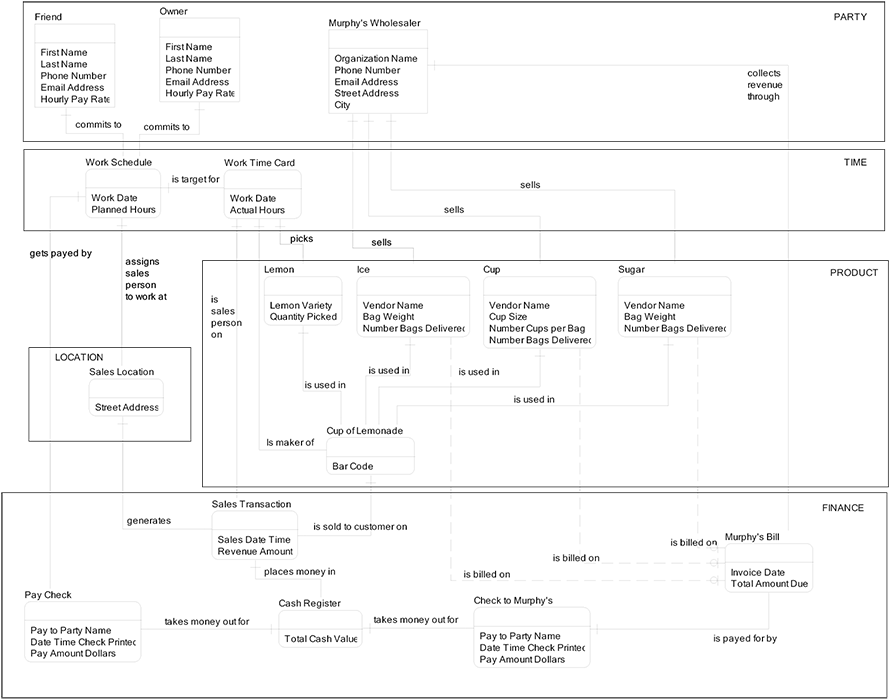
Above is the CDM with a few of the major attributes included to give it more meaning. Uniqueness constraints do not belong in a CDM, so they are blank. Further, CDM attributes do not conform to normalization theory.
Logical Data Model
Logical data models do not specify any particular technologies - we could implement the models below with a relational database, or we could use pencil and paper. Sample data values are displayed to indicate some of the data values that might reside inside of the entities.

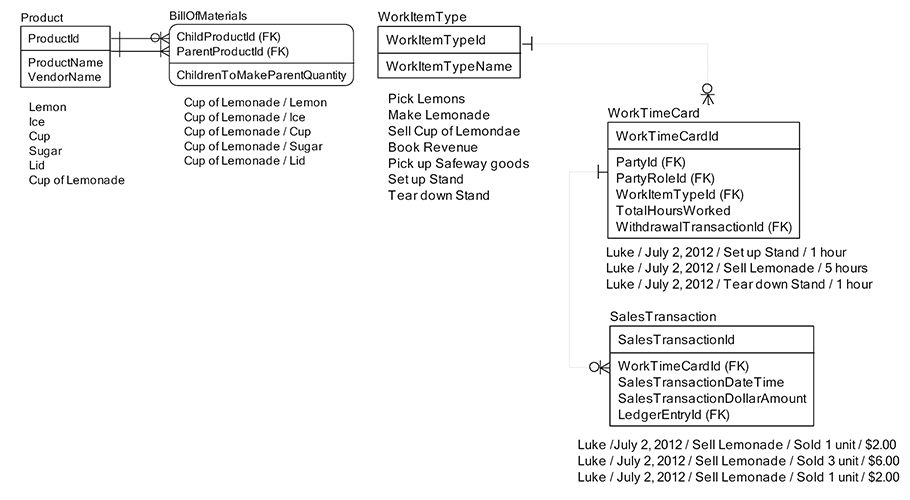
Here is the entire LDM for Season #1 (entity only level shown for readability):
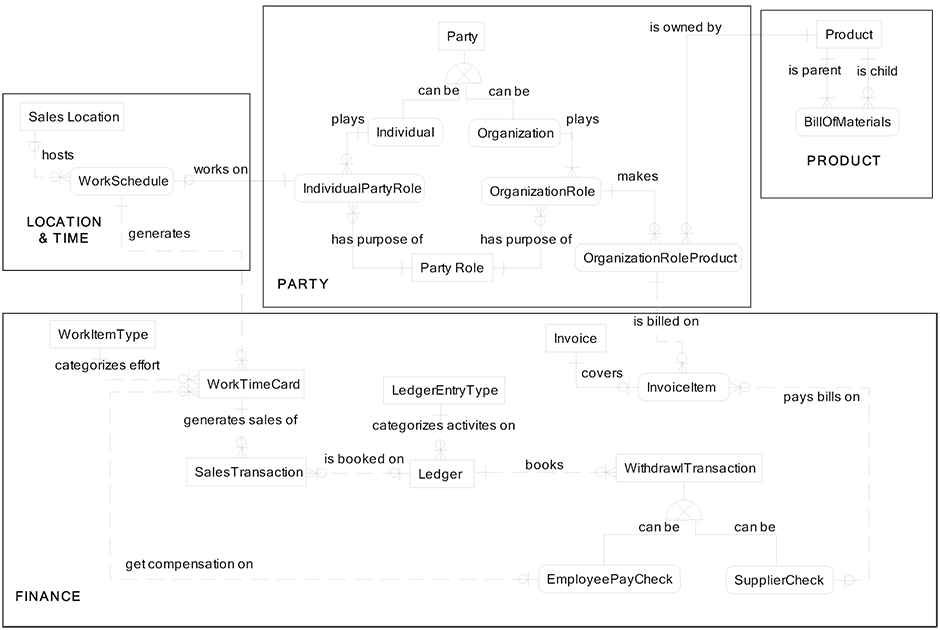
Here is a mapping from a concept to its logical counterparts:

Here is a description of each of the relationships:
- A party can be either an individual or an organization.
- Party roles define the purpose of both individuals and organizations.
- An individual party playing a role can commit to a work schedule.
- An organization party playing a role can deliver products (raw materials such as ice, sugar, cups).
- A product is composed of a collection of component products that, when assembled, create the finished goods product.
- A work schedule generates work time card entries that describe what work was actually done during that scheduled work period.
- The work item type describes the nature of the work being performed.
- A work time card can generate revenue on sales transactions.
- Each ledger entry is categorized by a ledger entry type.
- Sales transactions are booked on a ledger.
- The ledger records withdrawal transactions.
- Withdrawal transactions can be for either an employee paycheck or a supplier payment.
Here is a description of each of the entities in the Party subject area:
- Party–either an individual or an organization
- Individual–a person who has or will participate in the business
- Organization–a legal entity that has or will participate in the business
- Party Role–the set of purposes that parties may have
- Individual Party Role–the purpose of a person
- Organization Party Role–the purpose of a legal entity
- Organization Role Product–the set of products produced by an organization
And a description of each of the entities in the Product subject area:
- Product–the thing being sold (finished goods) or some component of the thing being sold (component as work in progress)
- Bill of Materials–the list of component products needed to build finished goods
And a description of each of the entities in the Location and Time subject area:
- Sales Location–the place where the lemonade stand resides
- Work Schedule–the time and place that a person will work at a lemonade stand
And a description of each of the entities in the Finance subject area:
- Work Item Type–a categorization of the type of effort that a person is doing during his work time
- Work Time Card–a record of who worked for how long doing which work item type
- Sales Transaction–the event that exchanges finished goods for money and records the revenue in the ledger
- Ledger Entry Type–a categorization of the reasons for recording financial transactions
- Ledger–the place where financial transactions are stored
- Withdrawal Transactions–the event that pays either our employees or our partners who supply us with goods and services
Physical Data Model
The physical model was being implemented on SQL Server. With the logical data model complete, we only needed to alter the PDM physical model to take advantage of the strengths of SQL Server and avoid its weaknesses. In this case, we changed the LDM subtypes under Withdrawal Transaction to be one to one relationships, since SQL Server has no declarative relationship for sub-types.
Note that in relational database systems the designer of the database can execute a single command to declare relationship rules called “referential integrity” rules. Then all processes that execute against the system inherit this rule, with no exceptions.
Next we dropped the LDM Party entity and moved the LDM attributes of Party redundantly into the PDM Individual table and into the PDM Organization tables. For example, the Party entity in the LDM had attributes of phone number, email address, and street address. Now these attributes have been copied to both the PDM Individual table and the PDM Organization table.
This should have been a high profit margin business since the lemons were all free, but an unusually rainy summer cast a dark shadow on demand for lemonade. In addition, Luke’s employees got $7.25 per hour and goofed off for at least half of their working time, making their effective pay rate $14.50 per hour.
The seasons and the earth would produce new fruit next year for Luke, an older and wiser entrepreneur. Luke would grow profitability next season with some geriatric ideas from dad and our best friend and neighbor, Trudy.
In Luke’s second season he was determined to avoid the pitfalls of his prior season. He reminded me that this season he will get some tips from dad. And these tips were to be specific to the lemon business on our property in our times (no more philosophy for Luke). We called in Trudy, our next door neighbor and best friend, for her consulting on how Luke’s Lemons Season #2 could bear more financial fruits than the dreaded Season #1.
Trudy and Luke play lots of creative games together and laugh quite a bit. One of their games is called “stuffies,” where they take stuffed animals and put on plays, play games, and invent a community of characters that have a blast every minute. Trudy suggested we put on a play called “last summer’s lemon business.” Then after the play was over, we could sit and talk about how the characters and plot can change for next year’s efforts.
- I played the customers who were thirsty and in a hurry, as played by a giraffe and a penguin.
- Trudy played Luke, the boss of the business, as played by a lion and a mouse.
- Luke played his friend Aden, who had a tough summer with little money and less time, as played by a teddy bear.
As the play got started, the “boss” kept alternating between strength (lion) and fearfulness (mouse). This allowed the workers to goof off several hours per day, and then when the “boss” morphed back to the lion, it triggered some actual work to get done.
Luke complained that Trudy’s character in the play was doing a disservice to his actual leadership skills. Both Trudy and dad agreed that reality and the play were highly aligned on this issue. Suddenly Luke announced that the play should stop. He tried again to revise history and claim strong leadership last summer, and then he started fishing for a way to have the workers lead themselves. Trudy grabbed her Post-It note and jotted down what would become “Tip #1 for Season #2.”
We resumed the play with a brief detour, as the animals spontaneously digressed into Star Wars followed by ninja warriors. As the play slowly morphed back to the original plot, the workers at Luke’s Lemons were complaining more and more. At one point, the bear, lion, and mouse were in a free-for-all wrestling match that caused collateral damage to the giraffe while he was trying to pay for his drink. Again Trudy scribbled a cryptic note, and, voilà, “Tip #2 for Season #2” was born.
As the stuffed animal play decayed in to a Three Stooges’ pie throwing contest, Trudy suggested we talk about next summer for a few minutes. We spent the next half hour brainstorming ideas for improving next summer. We used Post-It notes and a whiteboard; all ideas were respected and given a fair evaluation. The two winning ideas to be implemented next summer for Season #2 were as follows:
- Tip one was that each person should earn pay according to their sales. Each person would get an attribute called “Percent of Revenue as Wages.” The revenue not going to wages would be used as cash on hand for future business needs.
- Tip two was that each employee should understand both the value chain model and the data model and identify his responsibility on the models. This way there would be no confusion about each person’s roles and responsibilities.
This new business model takes care of employee motivation and employee education. People’s paychecks will be proportionate to their sales success. This avoids the employees goofing off half the time while getting paid full time. People’s understanding of where they fit in the value chain will be explicit, understood, and agreed to by all. This avoids the arguments about “Hey, dude, that’s not fair.”
I reminded Luke that he also gets a computing system in Season #2. Luke seemed uninterested in a computer with no games loaded. I reminded him that profitability and information management are strongly linked. We started with changes to the Season #1 CDM.
Conceptual Value Chain Model
In Season #1 Luke paid employees based on hours worked. In Season #2, he will be paying employees by a percent of their revenue generated on sales. So, while the value chain model at “level one” stays the same, there are changes to the calculation of paychecks for employees at the detail process level. In addition, we will remove the CDM attribute called Hourly Pay Rate and replace it with an attribute called Percent Revenue as Wages.
Next we will change the employee paycheck calculation from hourly to the following: In Sales Transaction, add up all revenue amounts for a given employee for a given week. Next, multiply that number by the Percent Revenue as Wages to determine the pay check pay amount dollars.
Luke wants to change employee assignments to be ready for Season #2. Last season Cyrus did all the work of going to Murphy’s and picking up the ice, sugar, and cups. He did not mind last season, since he got paid for every hour of this effort. Now Cyrus is rightfully complaining that next season he will be doing this work for no pay while other employees will use ice, sugar, and cups that he brought to them.
When presented with this situation, the boss, Luke, decided that each employee would take turns going to Murphy’s to pick up ice, sugar, and cups. This distributes the hours spent at Murphy’s evenly across all employees. Luke even offered to take his turn going to Murphy’s so that he would also absorb his fair share of this unpaid time. Finally, Luke needed to train each employee in the value chain process and make clear where they were responsible for taking action.
For Season #2, the data flow diagram of the value chain will be coded with who does what in the value chain. This documentation will be of value when arguments arise over who is doing how much work. The diagram on the facing page is Season #2 DFD with responsibilities marked with asterisks.
Since Trudy works in the medical field, where proper process and data flow can mean life or death, I asked her to train the boys on how to read a value chain data flow diagram. The boys were glad to have a new face teaching them about businesses and computing systems. Last season, each employee kept their own work plan on their personal calendar. This turned into the classic nightmare of storing data that is hidden from others in the value chain. Cyrus would update his work schedule and not tell the others. Then Luke and Aden would be waiting for Cyrus to come with the ice and he never showed up. Cyrus’ schedule was updated to reflect his fishing trip, but Luke and Aden never saw his schedule update.
All three boys agreed that Luke should collect labor availability schedules and publish the daily work plan each night to describe the coming work day. A phone call from Luke to Cyrus and Aden would make sure the next day’s schedule contained minimum surprises.
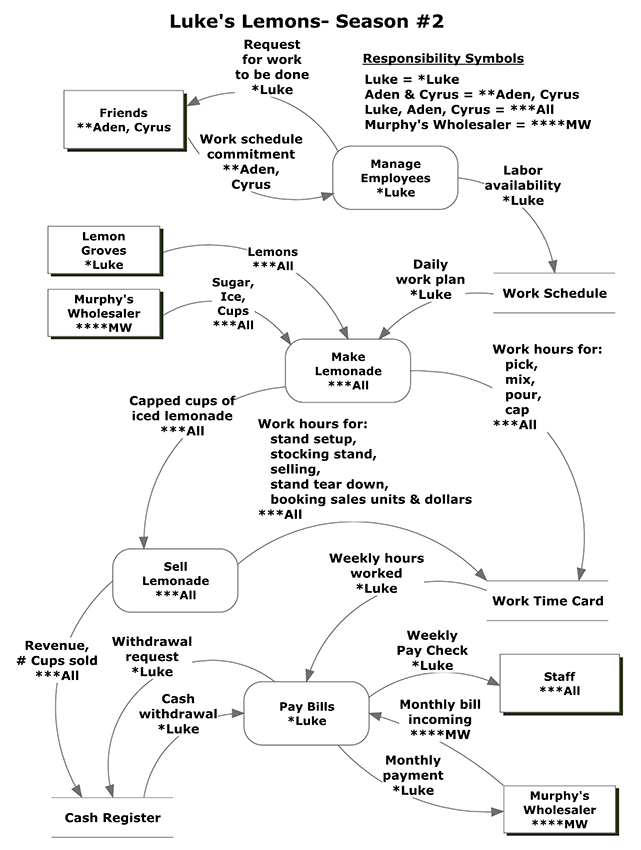
Conceptual Data Model
Here is the updated CDM:
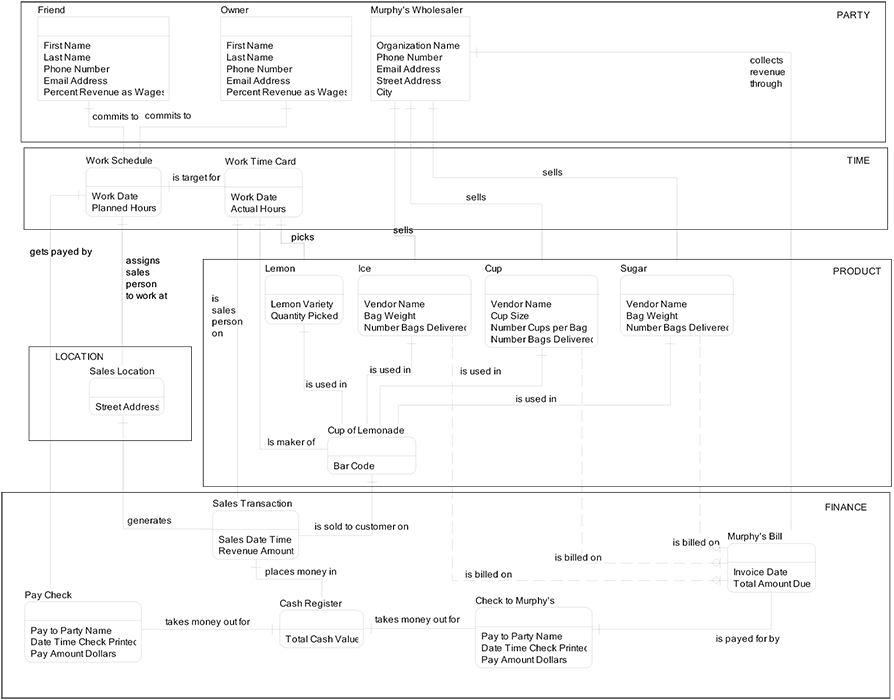
Logical Data Model
The LDM changes mirror the CDM changes closely. Hourly wage rate was removed and percent revenue as wages was added. The revenue that does not go to wages is added to the business’s cash on hand. This would allow next season’s business model to invest heavily in partners and sales.
When Cyrus and Aden saw the sample data, they were shocked at Luke’s 70% portion of his sales. Luke pointed out that this was just sample data in a CDM training course and the final values would land in the real computer system that dad was going to build before next summer.
Cyrus and Aden were not calmed by Luke’s assertion that final percentages were yet to be determined. They whimpered in unison “That’s not fair!” and Aden proclaimed that they should get 70% of their sales and Luke should get 55%.
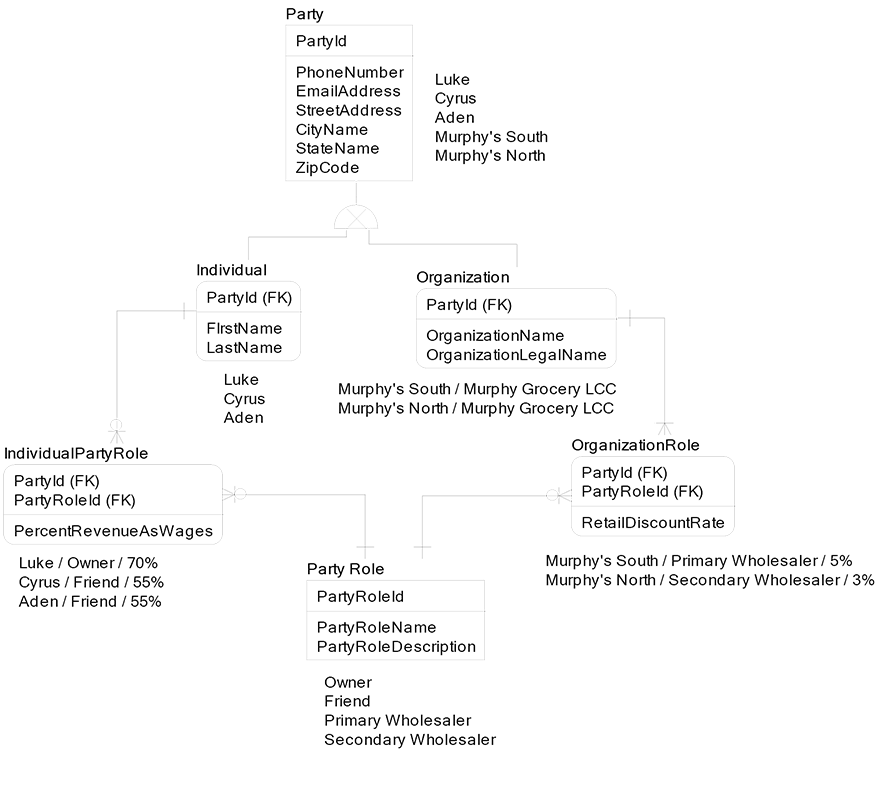
Trudy spotted a chance to resolve anger and conflict with some value chain thinking. She returned to the Season #2 DFD where the job responsibilities were marked with asterisks. She walked through a typical week and the people doing work had to stand during that part of their work description. Luke was standing almost the entire time. Aden and Cyrus were sitting more often than they might have expected.
Both Cyrus and Aden started to be sympathetic to the effort required to manage schedules, collect money, calculate paychecks for employees, pay Murphy’s, and manage all the squabbles that erupt daily, on top of picking lemons, squeezing, making lemonade, setting up the stand, selling, and tearing down the stand.
When Cyrus and Aden more fully appreciated the extra effort Luke was making, they looked at 70% as a plausible number for Luke next season. The value chain training was paying off already:
- Cooperation and teamwork was expanding as conflict and anger subsided. Understanding the larger context in which the entire team operates gives members an objective framework for discussion and compromise.
- Different brains that store the same value chain model become less divisive.
- Having a single paradigm to describe the business is good. Teaching this single paradigm to all participants is great!
Physical Data Model
The changes to the PDM are exactly like the changes to the LDM. The column hourly pay rate was removed and the column percent revenue as wages was added. The business logical that physically calculates employee paycheck amount needs to be changed to reflect the new revenue sharing logic.
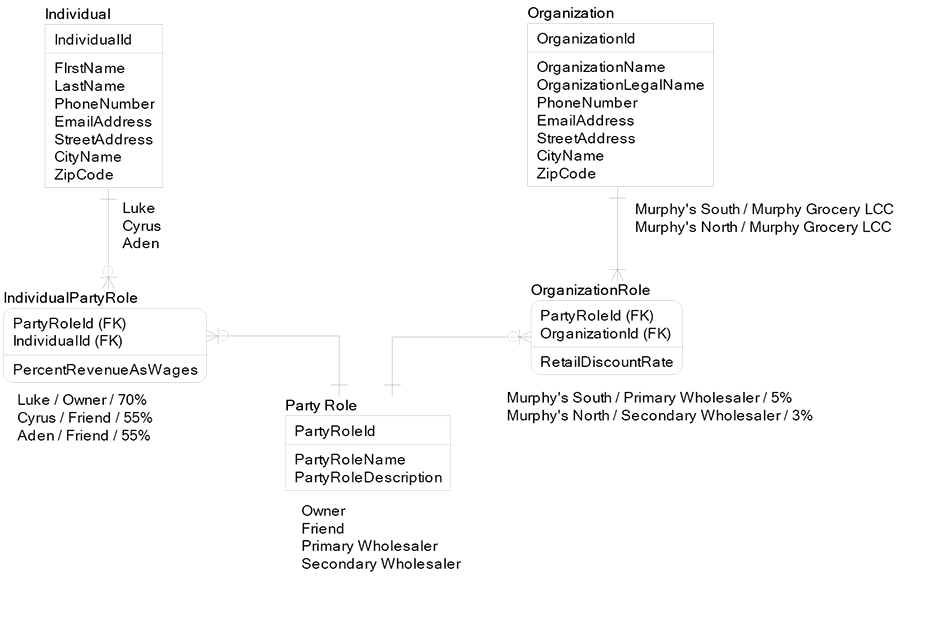
Trudy was looking at the data model above and wondered how the database design keeps us from having two party roles called “Owner.” We want one and only one party role called “Owner,” and that row called “Owner” has one description called “The person who manages the business and all finances.” Luke chimed in and wondered how the database design keeps us from having two party role descriptions that both read “The person who manages the business and all finances.”
These were both good questions since the PDM diagram above shows one uniqueness constraint on Party Role Id, and that value is assigned by SQL Server with a new value on every insert. This allows the following rows of data to be inserted to the table Party Role:

What the database diagram did not show are the alternate keys for uniqueness. The diagram showed only the primary key that is the column Party Role Id that is a system assigned key. There exist two more uniqueness constraints that are natural keys for uniqueness. These natural business keys are defined by the business. Aden jumped in and said that the table Individual suffers from the same problem in that the following rows can exist as documented by the database design diagram:

I opened my data modeling program and printed out the PDM with the AK option turned on. It looked like the diagram below and addresses all the uniqueness concerns (see the model on the facing page).
The table Party Role has three unique indexes: one primary key on Party Role Id, one alternate key on Partly Role Name, and another alternate key on Party Role Description. Individual requires all of the descriptive attributes for uniqueness and Organization requires all but one descriptive attribute for uniqueness.
After a few hot days of selling near the local parade and fair, the thought of earning $88 in a single day was nirvana. When nirvana materializes in your wallet, your attitude can mellow without much effort. The boys worked hard, and each earned over $1,400. They were not only enjoying the fruits of their lemon labor (games, trips, bikes), but they were also developing the positive feelings that come from the virtuous cycle of plan, work, and measure—and then suddenly you have over a thousand dollars.
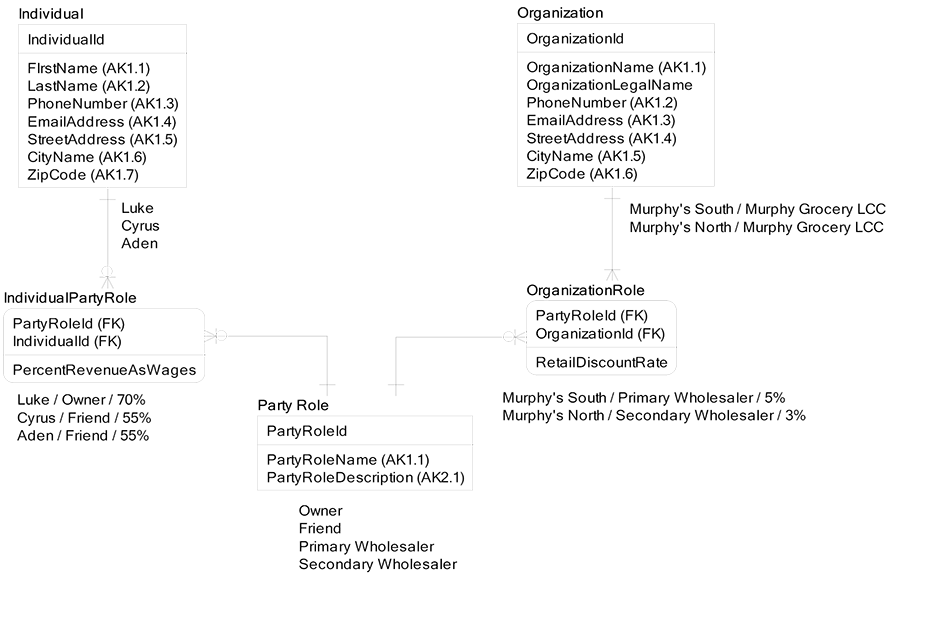
Luke’s Lemons business had $2,100 in cash on hand after Season #2. The feeling of “work begets success” needs to become ingrained in youth to stick well. The boys had grown significantly from last season’s bickering, shouting, and minimum wage summer. Things like getting along, working together, compromise, hard work, and the fruits of reward at the end of work are things that are hard to learn as an adult and come naturally to boys and young men. I was in Boy Scouts for years and found many of these same skills emerge naturally from participation in Scouting activities. I was an Eagle Scout, Boy Scout Master, and worked as a District Executive for the Boy Scouts.
I will get Luke involved with Boy Scouts as soon as he reaches age 11. He has already announced his protest about camping and hiking. Too bad for him; he will learn to grow in the lemon business, and then he will learn to grow some more in Scouting.
The computing system I built for Luke was tolerated by the boys at first. It was “uncool” to be seen using my system. But when the cash started coming in large waves, the computational power of our computing system was clearly saving them hours and hours of work. My friend Scott did the user interface, and I did the database work. It wasn’t pretty, but it did the job.
At the end of Season #2, the boys all agreed that dad’s little IT system was “surprisingly valuable.” I am pretty sure that Gutenberg’s children found the printing press to be “surprisingly valuable” as well. We had a few basic queries that ran on the database to track the progress of the business. Next season, we would take the database and transform it into a business intelligence structure of facts and dimensions. This would open the doors to hundreds of meaningful views of reporting. Scott and I are hoping to take our volunteer IT shop beyond the “surprisingly valuable,” all the way to just plain valuable.
Season #3 would turn out to be highly transformational for Luke’s business. In the first two seasons, Luke let over 98% of the lemons go to waste on the ground. In the next season, the waste would drop precipitously and profits would grow nicely. We started planning Season #3 in late October, so I had lots of time to adjust the computing system, and Luke had lots of time to prepare the employees with training.
Last season, Luke really enjoyed the tranquility of operating a business where responsibility was clearly understood and teamwork just seemed to flow. During a severe thunderstorm, Trudy, Luke, and I sat down to start planning the coming summer’s business model. I was excited since they had quite a large stash of cash on hand to enlist help with a new summer of selling. Trudy said that in her opinion, the biggest problem was that Luke’s business lacked specialization in the division of labor.
When everybody does everything in a business, there is no chance for people to specialize in a task and gain efficiencies from that specialization. Luke, Cyrus, and Aden all do picking, squeezing lemons, mixing sugar, making cups of lemonade, transporting lemonade to the sales site, setting up the sales stand, selling, taking money, recording money, and tearing down the sales stand.
Luke was confused and ambivalent on the topic of specialization, so Trudy used her former part-time jewelry business as the example. Trudy did not operate a mine digging for silver and gold, and she did not rock-hunt semi-precious stones. Further, Trudy did not operate a smelter to melt the metal into chains, earrings, rings, and bracelets. Trudy did not polish and cut the stones into shapes suitable for jewelry. What Trudy did do was to purchase the chains, rings, and stones and combine them in new ways to create jewelry. Finally, Trudy sold the jewelry at the annual jewelry exposition and at the monthly county auction.
The lesson here was that Trudy did not have to learn mining, smelting, rock hunting, and rock shaping. Also, she did not have to organize a jewelry exposition or the monthly county auctions. She did, however, combine the works of other specialists in unique ways to create her jewelry. Luke got the principle and applied it immediately. He had been playing with his new friends, Jose and Manuel, at the county park. Their family’s truck broke down just outside of town, and they were camping in the park.
Luke knew that Jose and Manuel had parents who specialized in picking fruit although they don’t have green cards. Without green cards they work only the harvest season, but the boys said they would be back next July to pick oranges in the southern part of the county. The kids were always looking for small jobs while the parents picked the large crops. Luke said he would ask if they could pick next summer’s lemon crop and, if so, how much they would charge.
Next it was my turn to apply Trudy’s lesson. The local soda factory was scheduled to be shut down in May. The Koch Soda Company was opening a plant in Mexico. All the current workers were to be fired, and their jobs were being shipped off to cheaper labor markets. The brothers who owned the Koch Soda Company viewed themselves as loyal Americans who were working hard to build a better America for our children and grandchildren. We all look in the mirror and see a rosy version of our true less-than-rosy colored nature. The workers at the Koch plant were collecting money to buy the equipment at the auction. They were also negotiating to rent the plant. The equipment sale price and the building rent would certainly be very low, since empty factory buildings were commonplace in our ailing economy.
I promised to contact the soon-to-be former Koch workers and see if they would like to produce cans of lemonade for us next summer. It would not be a large contract, but several small contracts could keep the factory busy enough to remain viable. The workers hoped to keep the plant open for at least a year while they looked for other jobs.
As the rain stopped, we decided that a bike trip to the park would be fun, so off we went to see the fall tree colors and feel the last warm breeze before winter arrives. During our bike trip, Luke said we should stop so we could talk. He had just figured out that if Jose and Manuel’s family pick huge amounts of lemons, and if the former Koch factory produces thousands of cans of lemonade, how could he and Cyrus and Aden sell this gargantuan supply of lemonade?
We were standing near the canoe rental stand and decided to take a canoe trip and discuss the mismatch between lemon supply and demand in Luke’s new business model. We were halfway out into the lake before anybody had a solution that was halfway feasible. Trudy came up with the first real idea from something she had read in the paper. The local baseball team was tearing down a perfectly good stadium and was going to build a “nicer facility” on the property. The government was paying for the majority of the costs, since no business person with a calculator and an accountant would have ever tried such a wasteful project.
The county government would run the vendor refreshment stands in the new stadium next summer. They would staff the refreshment stands with members from the local Boy Scout troops. In exchange, the troops would be able to use the county lake and camping facilities for half price. Trudy knew of my extensive contacts with the Boy Scouts and asked me to find out who in the organization was interacting with the county government. With that name, we could petition that person to promote Luke’s Lemonade product line to the county official running the refreshment stands. This idea was great since the baseball stadium crowd consumes huge amounts of refreshments.
Not to be outdone, I strained my neural landscape for connections that could move large volumes of lemonade. After 15 minutes of rowing and thinking, I uncovered a reasonable idea for selling large volumes of lemonade. The builder who added a bedroom to my house has a brother, Mark, who builds the display stands for all the vendors at the fairgrounds stadium. The stadium houses the county fair, quilting show, auto show, and several other major events each summer. Mark knows the manager of the refreshment stands and is best friends with the beer vendor. I promised to contact Mark and see if the beer vendor would like to add lemonade to his offerings in order to appeal to a broader demographic of thirsty people.
The outlook for next summer looked amazing as we biked home into the driveway. In the coming months, many pieces of the puzzle fell into place. Luke landed a contract to provide lemonade to the baseball stadium and signed a smaller contract with the fairgrounds beer vendor. Jose and Manuel agreed to come with their brothers to pick lemons next summer at a high rate of productivity and a low wage. The union members at the soon-to-be-defunct Koch Soda plant agreed to produce cans of lemonade at a fraction of the market price. The new business would be non-union and, as such, charged lower prices. The new company at the former Koch Soda plant will be called “Of, By & For the Workers Incorporated.”
What a strange feedback loop of things in this business model! All of them are interrelated, and all of them are part good and part bad. Our brains are built to create bulletproof certainty about good guys and bad guys; it is a challenge to remember that all things are a blend of good and bad.
Below are some aspects of Luke’s new business model for Season #3 with a list of the good and bad things:
Low wage illegal Mexican workers pick lemons:

The laid-off workers had their old high paying jobs disappear to Mexico:

I was starting to redesign Luke’s computer system for next season when he announced a change to his business model. The brothers who owned the Koch Soda plant would not be firing the workers who squeeze fruit to make juice. All the Koch workers who mix juice and sugar and can the finished drink will be laid off.
Luke was vehement about not doing business with the Koch family since his best friend’s father was losing his job. He was searching high and low for someone who could squeeze juice in the volumes and costs required. His only option was to have the lemons shipped 140 miles to a high cost plant in a neighboring state. This would involve extra time, transportation expense, and the juicing costs would be 40% higher. Luke’s anger with the Koch family was understandable. I found them somewhat distasteful in many ways as well, but there was a broader lesson to be learned from this situation.
Our consciousness is usually occupied by a mix of both intuitive and rational thinking. A sign that there is too much intuitive thinking getting into our consciousness is absolute certainty. If you are 100% sure that I am bad and you are good, stop for a moment and analyze how it is that I might be a little good and you might be a little bad. If you are 100% sure that I am wrong and you are right, stop for a moment and analyze how it is that I might be a little bit right and you might be a little bit wrong. This step of “stop for a moment and analyze” requires us to be self-conscious of when we are letting our primitive intuitive-thinking brain occupy too many neurons in our consciousness.
Luke jumped in and correctly predicted my suggestion of meditation. He was too young and too squirmy to benefit, so I promised we would not try this again until he was older. Meditation builds a meta-consciousness about normal consciousness to monitor for the presence of thoughts during meditation. This meta-consciousness is used to detect the absence of silence in consciousness during meditation. Meditation physically rewires the brain using neuropeptides to maximize rational thinking’s footprint in consciousness. Meditation builds a capacity for consciousness to be conscious of itself. This skill is need if we are to monitor the mix of intuitive and rational thinking in our consciousness. This skill is needed if we are to monitor consciousness for silence during meditation.
It is amazing to me that that we all have the capacity to sit with a silent mind focused on breath, and that this simple activity rewires our caveman brains so that we can function with greater peace and equanimity. Yet we are too busy being certain to take the time to act on the thought, “I should sit with no thoughts.”
So what does this mean for Luke’s Lemons Season #3? Next season we will:
- Offer meditation and breakfast on Mondays, Wednesdays, and Fridays at Luke’s house
- Get to know the brothers who run Koch Soda as people who, like us, are good and bad. Then we will select a vendor to juice lemons based on “rational thinking”
- Monitor our thinking and behavior for signs of certainty in our intuitive thinking
- Openly discuss our intuitive-thinking behaviors using rational-thinking for the discussion and analysis
So we scheduled time to meet with Willard and Francis Koch to get to know them as people and to discuss their outsourcing behavior. When we met with the Koch brothers, we found out that they had just been through an agonizing Alzheimer’s death with their mother. Luke had just been through an equally heartbreaking experience losing his grandmother to the same disease. As we discussed the myriad emotions of watching a loved one lose, regain, and then lose completely the capacity to think, we agreed that only those who have experienced Alzheimer’s can actually understand the disease. When the topic of Boy Scouts was raised by Luke, the Koch brothers asked how the new summer camp swimming pool was doing. Cyrus had told us it was a total blast, so we reiterated his observation. It came out later that the Koch brothers had donated funds to build swimming pools for both the Boy Scouts and the Girl Scouts. So there were lots of good things about the Koch brothers that Luke had not expected.
But when the topic of outsourcing came up, the Koch brothers were certain that it was “the only option that they could find.” The high costs of union labor and benefits were making their soda so expensive that fewer people were buying it. The profit margins were shrinking. They had “no choice”. Trudy, who had not said a word in the entire meeting, piped up and reminded the brothers that last year each brother netted over $480,000 from Koch Soda. While it is true that things needed to get better with union wages and shrinking market share, she could not see $480,000 of income as being at the panic-triggering level.
Trudy explained that the expanding sports drink market was the main reason for Koch Soda market share reduction; union costs contributed a minor amount to slowing sales. Luke suggested they diversify their product line to include more “health drinks.” The Koch brothers instantaneously responded with unmitigated absolute unwavering certainty, stating in operatic unison “we have no choice but to close this factory.” Being certain and being wrong are frequently close partners, I think.
After long discussions with Koch fruit juicing people, Luke arrived at a very reasonable price for Koch doing the squeezing of lemons into juice. They had to drop the price, since the soon-to-be-defunct Koch Soda canning factory was removing 40% of their revenue. With the demand for squeezing down, Luke got a squeezing price break. Yes, Luke was happy with the price for squeezing, and was equally glad he got to know the Koch brothers. They were like all of us, a mix of both good and bad. But with patience and lots of rational thinking, we found a way to build a good win/win relationship.
Conceptual Value Chain Model
On the next page is the conceptual value chain model for Luke’s Lemons, Season #3, and below is a description of each of the actions.
- Each Monday morning, Luke contacts the baseball stadium and the fairgrounds to determine how many lemonade six-packs they will need for the following Monday. This gives him a full week to prepare all the lemonade. The baseball stadium and the fairgrounds pay Luke in advance for the number of six-packs they will be getting the next week.
- Luke adds up the six-packs for the baseball stadium and the fairgrounds. Then he translates the total needed into how many bushels of lemons are needed. Luke tells Jose and Manuel how many bushels to pick. Jose and Manuel are paid for the picking in advance of them actually doing the work.
- Jose and Manuel pick the proper number of bushels of lemons.
- They transport the lemons to the Koch Juicer building.
- Luke tells the Koch Juicer manager how many gallons of juice are needed for next Monday’s delivery. Luke pays Koch for the juice in advance. The lemons are squeezed and the juice bottled into the proper number of gallons.
- The gallons of juice are transported by Koch to the company Of, By, & For the Workers, Inc.
- Luke tells the manager at Of, By, & For the Workers, Inc. how many six-packs of lemonade are needed. Luke pays them in advance for both the six-packs and for the shipping.
- Of, By, & For the Workers, Inc. takes the juice and adds water and sugar, and then cans the lemon juice to make lemonade. The cans are connected into six-packs by a machine.
- The six-packs are transported to Cyrus and Aden. Cyrus and Aden are paid in advance for their distribution work.
- Cyrus and Aden separate the six-packs into the proper quantities for each customer.
- Cyrus delivers six-packs to the baseball stadium. Aden delivers six-packs to the fairgrounds.
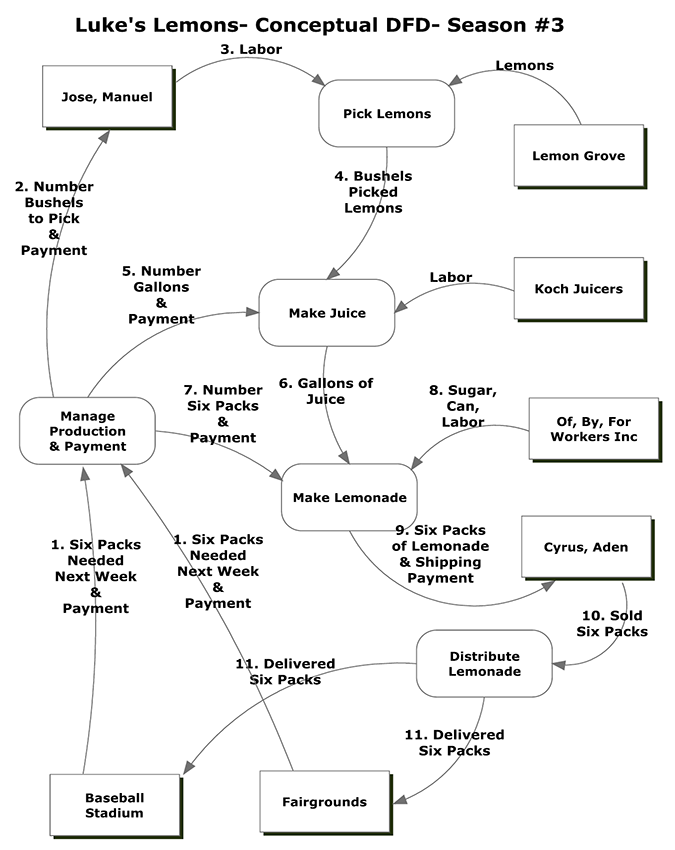
Conceptual Data Model
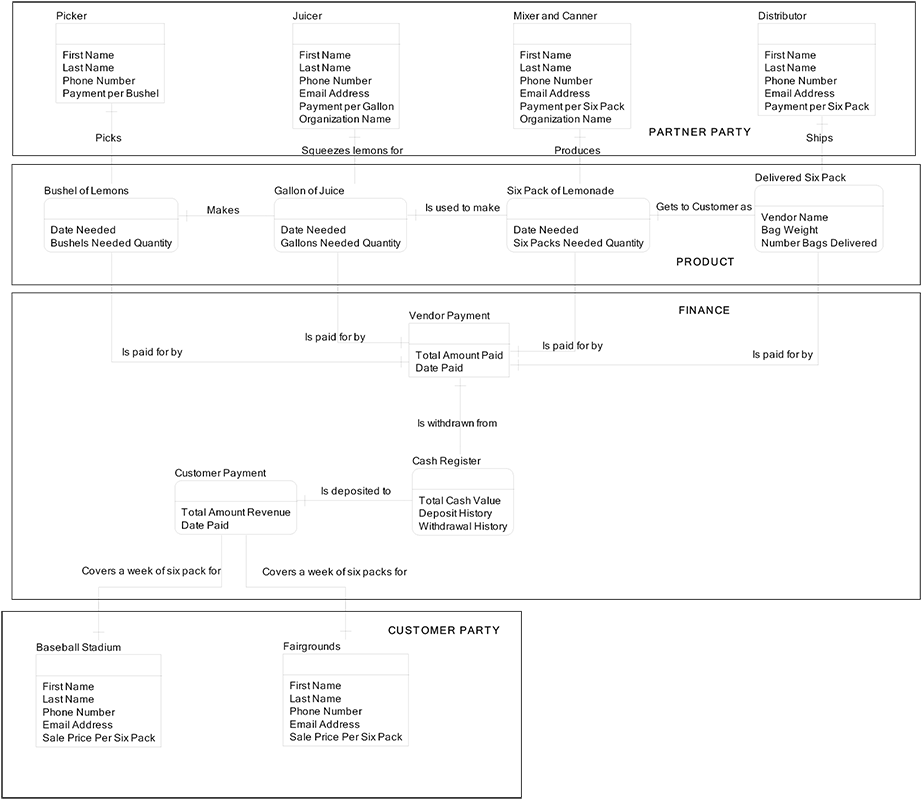
Here is a description of each of the relationships:
- A picker picks lemons to fill a bushel basket.
- A juicer squeezes lemons to make a gallon of juice.
- A mixer and canner produces a six-pack of lemonade by mixing juice, water, and sugar; sealing it into a can; and then attaches six cans into a single package.
- A distributor sorts the six-packs into quantities for each customer and then delivers the appropriate quantity to each customer.
- A bushel of lemons is paid for by a vendor payment made in advance of the lemons being picked.
- A gallon of juice is paid for by a vendor payment made in advance of the juice being made.
- A six-pack of lemonade is paid for by a vendor payment that is made in advance of the six-packs being made.
- A delivered six-pack is paid for by a vendor payment and is made in advance of the shipping of the six-packs.
- Each vendor payment is withdrawn from the cash register.
- Each customer payment for six-packs of lemonade is deposited to the cash register.
- Each customer payment covers a week of lemonade for the baseball stadium.
- Each customer payment covers a week of lemonade for the fairgrounds.
Here is a description of each of the entities, grouped by subject area:
- Party
- Picker–the people who use ladders to pick the lemons from the trees and place them in bushel baskets.
- Juicer–the people who squeeze the lemons to make lemon juice.
- Mixer and Canner–the people who mix lemon juice, water, and sugar and seal it into cans to make lemonade. The cans are grouped into six-packs.
- Distributor–the people who deliver six-packs of lemonade to the customers.
- Baseball Stadium–the people who sell refreshments to the audience at baseball games.
- Fairgrounds–the people who sell refreshments to attendees at the fairground events.
- Product
- Bushel of Lemons–a basket filled with lemons. Each bushel holds about 500 lemons.
- Gallon of Juice–a jar of lemon juice. Each bushel makes about two gallons of juice.
- Six-pack of Lemonade–six cans of lemonade attached in a single package. Each gallon of juice makes about 3 six-packs.
- Delivered Six-pack–the customer’s quantities of six-packs sitting on their loading dock.
- Finance
- Vendor Payment–a record of when and how much Luke’s Lemons has paid to each vendor to cover the work they performed in the lemonade business.
- Cash Register–the place where funds are stored.
- Customer Payment–a record of when and how much each customer has paid to Luke’s Lemons in exchange for lemonade.
Logical Value Chain Model
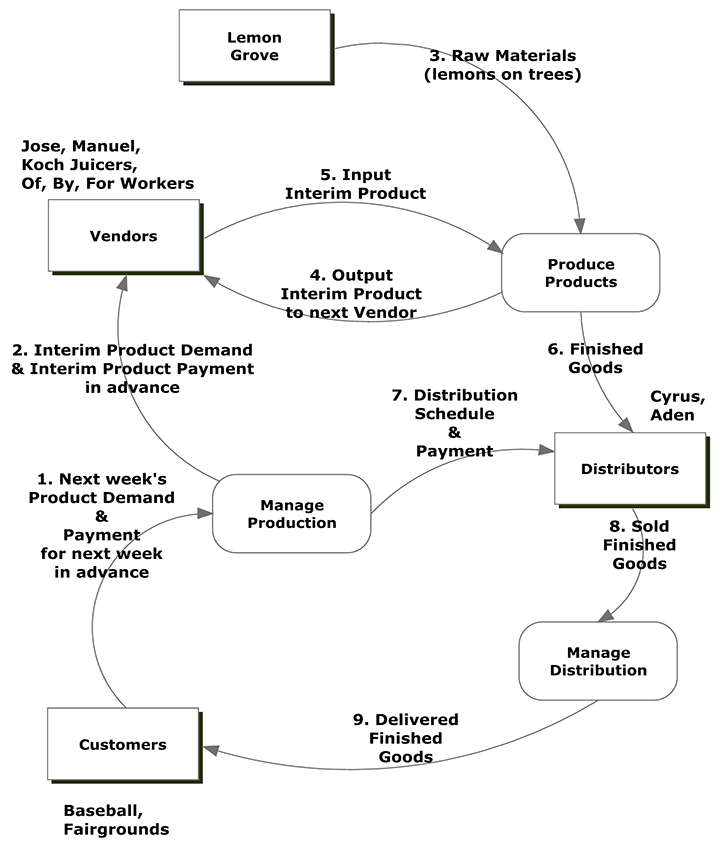
Logical Data Model
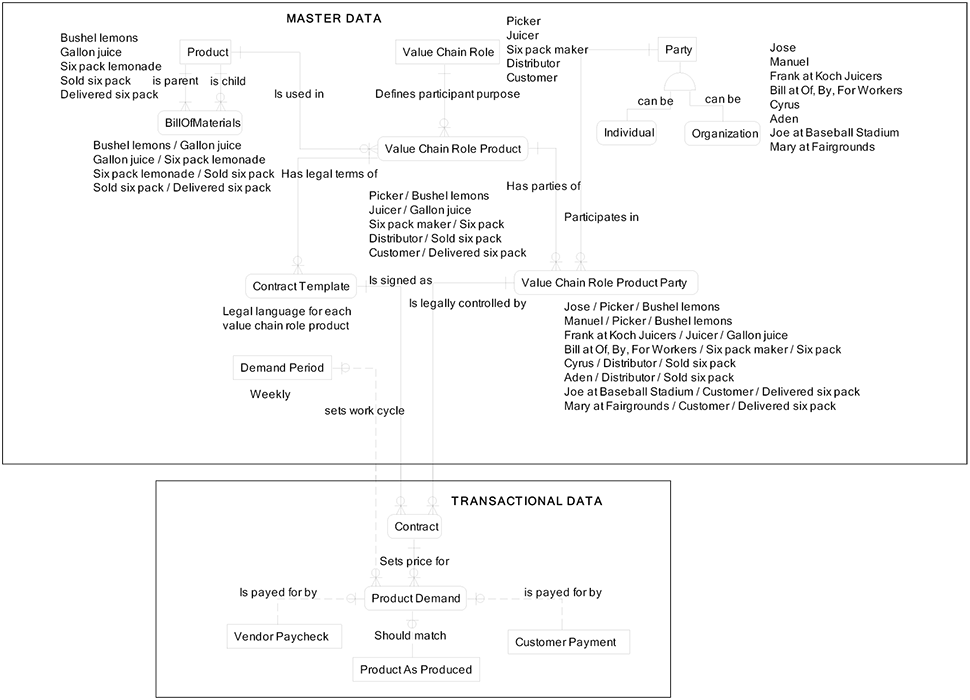
Here is a description of each of the relationships:
- A party cannot be both an individual and an organization. A party can be just an individual, or it can be just an organization.
- A value chain role defines each participant’s purpose when dealing with a product.
- A product can be a parent in the bill of materials.
- A product can be a child in the bill of materials.
- A product is used in a value chain role product.
- Each value chain role product has legal terms and conditions stored in a contract template.
- Each value chain role product has parties associated in the value chain role product party.
- Each contract template is copied and signed to become a contract.
- Each value chain role product party has behavior controlled by the legal terms of the contract.
- Each contract sets the price for products as demanded each week by the customer.
- Each demand period defines the interval for forecasting and delivery of products.
- The production costs of product demand are paid for by the vendor paycheck.
- The consumer revenue generated by product demand is paid for by the customer payment.
- The product as produced should match the product demand. If the product demand does not match the product as produced and delivered, then a credit or debit adjustment will be issued at the end of the summer to each party.
Here is a description of each of the master data entities, grouped by subject area:
Product
- Product–the finished goods or the interim product or the raw materials. Finished goods are six-packs of lemonade, Interim products are bushels of lemons, gallons of juice and Raw material products are lemons on trees.
- Bill of Materials–the assembly structure to get from raw materials to interim products to finished goods.
Party
- Party–the collection of people and organizations involved in Luke’s Lemons, Inc.
- Individual–the people involved in Luke’s Lemons, Inc.
- Organization–the legal business entities involved in Luke’s Lemons, Inc.
Value Chain Design
- Value Chain Role–the purpose of each party in Luke’s Lemons, Inc.
- Value Chain Role Product–the products delivered by each value chain role.
- Value Chain Role Product Party–the parties who will execute a value chain role to product a product.
- Contract Template–the legal language constraining behavior for each value chain role and the product it will produce.
- Demand Period–the interval for which product demand will be forecast and the interval for product delivery to customer.
Here is a description of each of the transactional data entities:
- Contract–an instance of a contract template that constrains the behavior of all parties in the lemonade value chain.
- Product Demand–a forecast of how much lemonade a customer will need for a given demand period or a request for a partner party to produce bushels of lemons, gallons of juice, or six-packs of lemonade for a given demand period.
- Vendor Paycheck–the payment to parties who contributed value in the lemonade value chain.
- Customer Payment–revenue collected by Luke’s Lemons, Inc. in exchange for lemonade to be delivered to the customer.
- Product as Produced–the actual number of six-packs delivered to meet the product demand the customer gave us a week prior. If the demanded product and the produced product quantities are different, adjustments will be made to compensate for the difference.
Business intelligence data is created by transforming the master data and transactional data into a star schema. Star schemas have a fact table that is the finest granularity of metric in the design, and the fact table has various dimensions that serve as aggregation criteria for the facts. On the facing page is a star schema transformed from the Season #3 LDM.
We can mix and match dimensions to create thousands of queries on the star schema. Below are just a few of the queries that are possible:
- For the month of July, for Bushels of lemons, sum the payments
- For the month of July, for Bushels of lemons, sum the payments and divide the total July revenue by the sum of payments for Bushels of lemons for July
- For Manuel, sum payments
- For Customer of Mary Short / Fairgrounds, for July, sum the revenue
The progress in Luke’s business over three summers was truly gratifying for all of the participants. He had grown from a mischievous little boy into a confident, mischievous big boy. This sounds like a small change, but a sense of self-confidence is the basis for forgiving and compromise. Cyrus and Aden had both experienced similar maturity, as their families were proud to testify.
The only bump in the road this season came towards the end of the summer when we were running out of lemons. The baseball team was in the playoffs, and the boys could see that they would be completely out of lemons sometime during the playoffs. This crisis precipitated a partnership with our neighbor Hank, who has seven acres of lemon trees. We added Hank and his kids to our value chain process at the last minute and ended up serving lemonade all through the sold-out playoffs. With the computing system and processes built around value chain and data models, the addition of our neighbors to the process and system was easy and fast, as planned.

The boys raked in about $9,900.00 each, leaving the business with $4,200.00 cash on hand. As in previous summers, all the participants in Luke’s business had a clear understanding of how the value chain worked and used vocabulary from the data model in their conversations about the business. The computing system reinforced the vocabulary and flow in the value chain. We attributed much of our success to blind luck. The weather, the baseball team, the cheap picking labor, and a host of other lucky factors all just seemed to align for success. At the same time, I must say that Luke had a paradigm for how to approach his business that helped him to organize, structure, and orchestrate the pieces that accidentally fell his way. Once again, structure and creativity team up to generate synergy and success.
Data Model for Data Modeling and Value Chain
Below is a conceptual data model describing the entities and relationship involved in the CDM, LDM, conceptual value chain processes, and logical value chain process.
The transformation entities represent the engineering process that changes the CDM into the LDM for forward engineering and changes the LDM into the CDM for reverse engineering.
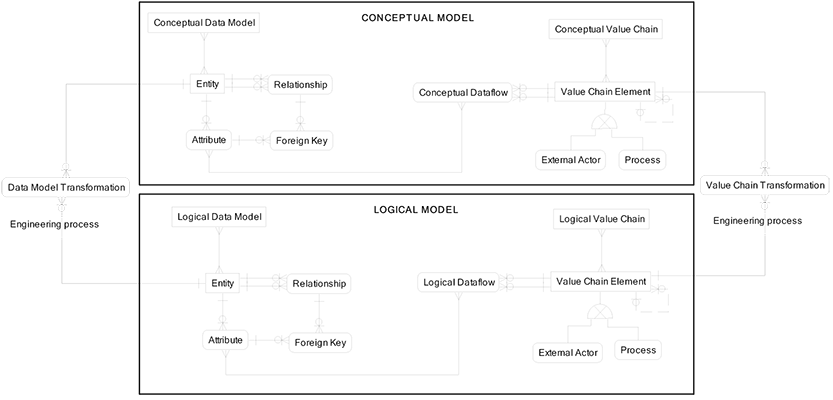
Forward Engineering the To-Be Business and System
Forward engineering is used to define a new and better way to operate your business and your computing systems. Forward engineering is a top-down process that starts with business experts envisioning a better tomorrow, then:
- A scope statement is formulated for the new project.
- Conceptual data models and value chains are designed.
- Logical data models and value chains are designed.
- Physical data models and value chains are designed.
- New human and machine physical instructions are built, tested, and deployed.
- The project operates as part of the real world.
The top-down design of tomorrow’s world is called the to-be design.
Reverse Engineering the As-Is Business and System
Reverse engineering is a bit of a misnomer. John Zachman once said you cannot reverse engineer something that was not engineered when it was designed and built. A better phrase would be “documenting what you have today.” An example, bottom-up, documenting what you have today:
- The executable computing system components are documented by the source code
- Database source code can be documented by physical data model graphic and text
- Physical database diagrams can be documented by logical model graphic and text
- Logical data model diagrams can be documented by conceptual model graphic and text
- Conceptual data model diagrams can be placed in a context with a statement of scope
Fast Forward
Luke’s summer lemon business continued to evolve over the years. He eventually took over the computing system that ran his business. I would review his software designs, but he, Cyrus, and Aden did all the coding and testing. The early seasons when profitability spiked were never duplicated. The businesses profits flattened out for several years, although the boys were still making good money for a summer job.
Boy Scouts
I forced Luke to participate in Boy Scouts starting in fifth grade. It was the standard story; complain for a few months and then enjoy the next seven years. Since Cyrus and Aden joined the same troop, it made it easier for Luke to hike through the woods, sleep on the ground, and struggle with the vicissitudes of nature. Luke never grew to fully enjoy camping, but he learned many valuable lessons from scouting.
Job Before College
After Luke graduated from high school, he decided to work for a couple of years before starting college. I went from high school straight to college in 1967. As a student and touring rock guitar player, my college grades might have suffered more than my pride can discuss at this time. I was glad to hear Luke would start college with full time work experiences in his bag of tricks.
Final Lesson
Before Luke took off for college, I offered one final lesson on the whiteboard. He was in the process of declining when he abruptly stopped and said “Sure, one last lesson would be okay.” I knew he wanted to take his latest girlfriend to the movies that night, so I kept the lesson under 15 minutes.
We had bought the whiteboard when he was three; now he was getting one last lesson before launching off to college. I asked what topic he would like, and he picked “diversity and unity.” He clarified that his interest was in knowing how things are both “separate and unique” and “not separate and not unique.”
“Luke,” I said, “do you remember the data model and value chain model you made when you were 10 years old? Here is what it looks like from the viewpoint of diversity. All entities are separate and unique.” During our early tries at these designs, we laid out the things and talked about them before we created the relationships between things. On the facing page is an early version of Luke’s models for Season #1.

Next, I found our completed models with the relationships present. This web of formerly separate things is unity. If you grab one thing below and shake it, then entire web of related things will shake as well. Remember the spider webs that shook in unison? This is unity.
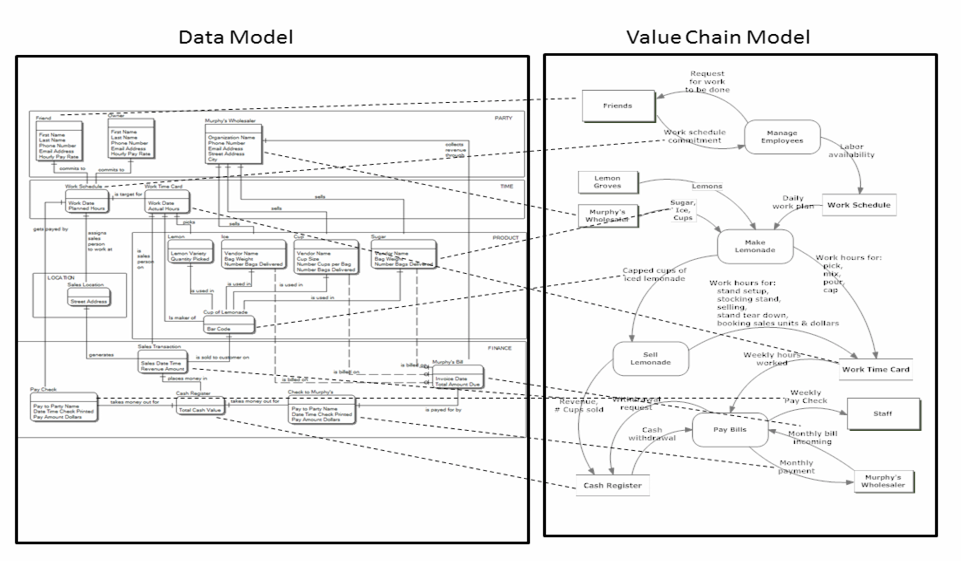
To answer Luke’s specific question about how things are both separate and not separate, I replied that things are not separate. We trick ourselves into seeing things as separate, but this illusion exists because our brains perceive a small slice of the real world.
When we started our design for the first season, we had separate boxes in our diagrams. We were seeing a simplification (small slice) of the complexity of the real world. Later, when we were ready to address more complexity, we started to weave a web from separate things. We added the flows in the value chain. We added the relationships to the data model. We added dashed lines to relate the data to the flow. With all interdependencies identified, we understood the full reality and meaning of the first summer in the lemon business.
